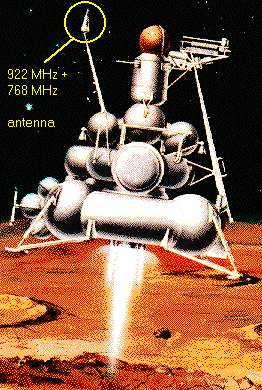

 Let assume that the antennas are quarter wave
rods fed part of the way up from the "ground" end. If that is so, then
antenna AA' is resonant at the frequency fA=300/(4 * 0.36)=208
MHz. The corresponding frequency for the BB' antenna rods is f´B=300/(4
* 0.57)=131.6 MHz. It is probably safe to assume that the antenna system
is operating a lower frequency than calculated here. Let us assume that
antenna AA' operates at 183 MHz, then one would have to apply a correction
factor to the frequency of antenna BB' equal to the ratio (183/208)=0.88.
If this is a correct way of reasoning then the BB' antenna worked on 0.88*131.6=115.8
MHz. Howeveer, recent data on the new webpage of the Lavochkin association
shows that the uplink was 101.965 MHz!
Let assume that the antennas are quarter wave
rods fed part of the way up from the "ground" end. If that is so, then
antenna AA' is resonant at the frequency fA=300/(4 * 0.36)=208
MHz. The corresponding frequency for the BB' antenna rods is f´B=300/(4
* 0.57)=131.6 MHz. It is probably safe to assume that the antenna system
is operating a lower frequency than calculated here. Let us assume that
antenna AA' operates at 183 MHz, then one would have to apply a correction
factor to the frequency of antenna BB' equal to the ratio (183/208)=0.88.
If this is a correct way of reasoning then the BB' antenna worked on 0.88*131.6=115.8
MHz. Howeveer, recent data on the new webpage of the Lavochkin association
shows that the uplink was 101.965 MHz!
In (1)
the wavelengths 1.6 m and 2.5 m are mentioned for the Luna series. 1.6
meters probably refers to 183.6 MHz (which is precisely 1.634 m). The wavelength
2.5 meters corresponds to 120 MHz. But, in connection with the flight of
Luna 15, the Soviet Union told NASA (2) that
the frequency 115 MHz was used. It is not clear of this was the up- or
downlink even though (2) indicates that it
is the downlink..
 The
landing radar system operated on 10 GHz according to Krupenio (3).
The picture below shows the radar antenna in its stowed position on the
landing module. (The picture below has been obtained from the Web site
of Alexander Chernov's
Virtual
Space Museum).
The
landing radar system operated on 10 GHz according to Krupenio (3).
The picture below shows the radar antenna in its stowed position on the
landing module. (The picture below has been obtained from the Web site
of Alexander Chernov's
Virtual
Space Museum).